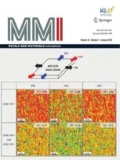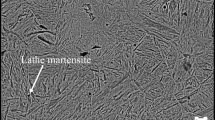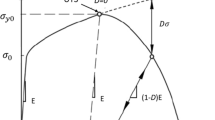Abstract
Understanding of material behavior of armour steel under large deformations and high strains during loading is very crucial in designing steel structures for various applications. Johnson–Cook flow stress and Johnson–Cook failure models were adopted for modeling and predicting the material flow behavior of armour plate. The material parameters of Johnson–Cook flow stress have been determined experimentally from tests performed at different strain rates (10−4–1550 s−1) and temperatures (25–600 °C). The damage parameters of Johnson–Cook failure model were determined through experiments on flat tensile specimens in combination with finite element simulation. Using these materials parameters, finite element simulations were performed on notch specimens of different radii between 2 mm and 20 mm loaded under tension. Load-strain curves were in good agreement with the experimentally obtained data. Triaxiality obtained from simulation were matched against the reported values from the literature.
Graphic Abstract















Similar content being viewed by others
References
S.J. Manganello, K.H. Abbott, J. Mater. 7, 231 (1972)
J.A. Zukas, D.R. Scheffler, Int. J. Solids Struct. 38, 3321 (2001)
G.R. Johnson, W.H. Cook, Eng. Fract. Mech. 21, 31 (1985)
N. Kılıc, S. Bedir, A. Erdik, B. Ekici, A. Tasdemirci, M. Guden, Mater. Des. 63, 427 (2014)
M.A. Iqbal, K. Senthil, P. Sharma, N.K. Gupta, Int. J. Impact Eng. 96, 146 (2016)
A. Banerjee, S. Dhar, S. Acharyya, D. Datta, N. Nayak, Mater. Sci. Eng. A 640, 200 (2015)
P. Skoglund, M. Nilsson, A. Tjernberg, J. Phys. 134, 197 (2006)
F.A. Mcclintock, J. Appl. Mech. 35, 363 (1968)
J.R. Rice, D.M. Tracey, J. Mech. Phys. Solids 17, 201 (1969)
J.W. Hancock, A.C. Mackenzie, J. Mech. Phys. Solids 24, 147 (1976)
P.W. Bridgman, Studies in Large Plastic Flow and Fracture (McGraw-Hill, New York, 1952), pp. 9–37
O.S. Hopperstad, T. Børvik, M. Langseth, K. Labibes, C. Albertini, Euro. J. Mech. A 22, 1 (2003)
B. Erice, F. Gálvez, D.A. Cendón, V. Sánchez-Gálvez, Eng. Fract. Mech. 79, 1 (2012)
A. Díaz, J.M. Alegre, I.I. Cuesta, Theor. Appl. Fract. Mech. 90, 294 (2017)
B. Erice, C.C. Roth, D. Mohr, Mech. Mater. 116, 11 (2018)
Y. Bai, X. Teng, T. Wierzbicki, J. Eng. Mater. Technol. 131, 021002 (2009)
J.H. Kim, D. Kim, H.N. Han, F. Barlat, M.G. Lee, Mater. Sci. Eng. A 559, 222 (2013)
S.-H. Joo, H. Kato, K. Gangwar, S. Lee, H.S. Kim, Intermetallics 32, 21 (2013)
S.-H. Joo, J.K. Lee, J.-M. Koo, D.W. Suh, S. Lee, H.S. Kim, Scripta Mater. 68, 245 (2013)
A.R. Chintha, K. Valtonen, V.T. Kuokkala, S. Kundu, M.J. Peet, H.K.D.H. Bhadeshia, Wear 428, 430 (2019)
K.K. Namala, P. Mahajan, N. Bhatnagar, Int. J. Comput. Methods Eng. Sci. Mech. 15, 203 (2014)
G.E. Dieter, Mechanical Metallurgy (McGraw-Hill Book Co., New York, 1988), pp. 275–324
Acknowledgements
This research was supported by Tata Steel, Jamshedpur (RD/PROP/COL/273/2017). The authors are thankful to TBRL,DRDO, Chandigarh for conducting high strain rate tests and to NML-CSIR, Jamshedpur for conducting high temperature tests. Dr. Mohit Gupta is thankfully acknowledged for useful discussions.
Funding
This research was supported by Tata Steel, Jamshedpur, India (RD/PROP/COL/273/2017).
Author information
Authors and Affiliations
Contributions
The specific contributions made by each author are listed below. SK: Conceptualization, Methodology, Investigation, Roles/Writing—original draft. KK: Software, Validation, Formal analysis. SC: Resources, Investigation. PKS: Resources, Investigation. RKV: Project administration. PM: Conceptualization, Methodology, Supervision, Writing—review and Editing, Funding Acquisition.
Corresponding author
Ethics declarations
Conflicts of interest
The authors declare that they have no known competing financial interests or personal relationships that could have appeared to influence the work reported in this paper.
Additional information
Publisher's Note
Springer Nature remains neutral with regard to jurisdictional claims in published maps and institutional affiliations.
Rights and permissions
About this article
Cite this article
Khare, S., Kumar, K., Choudhary, S. et al. Determination of Johnson–Cook Material Parameters for Armour Plate Using DIC and FEM. Met. Mater. Int. 27, 4984–4995 (2021). https://doi.org/10.1007/s12540-020-00895-3
Received:
Accepted:
Published:
Issue Date:
DOI: https://doi.org/10.1007/s12540-020-00895-3




